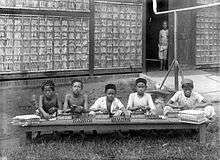Smoking in Indonesia

Smoking in Indonesia is common, as there are approximately 57 million smokers in Indonesia.[1] Of Indonesian people, 63% of men and 5% of women reported being smokers, a total of 34% of the population.[2] 88% of Indonesia smokers use clove-flavoured kreteks.[2] Kretek manufacturers directly employ over 180,000 people in Indonesia and an additional 10 million indirectly.[3] Indonesia is the fifth largest tobacco market in the world, and in 2008 over 165 billion cigarettes were sold in the country.[2] Major tobacco companies dominating the market in Indonesia include Gudang Garam, Sampoerna (Philip Morris International), Djarum, Bentoel Group (British American Tobacco) and Nojorono Tobacco International.[4] The WHO has ranked Indonesia third in the world for total number of smokers.[5]
Child smoking
According to an official spokesman of a special commission set up to protect children's rights (KPAI) and evolve regulations to prevent children getting addicted to smoking, "The future of 80 million Indonesian children is at stake as the cigarette producers were intentionally aiming children as their future market through massive TV advertisements and sponsorships on activities in which teenagers involved the most."[5]
More than 30% of Indonesian children reportedly smoke a cigarette before the age of 10.[6] In 2010, a two-year-old boy from Sumatra, Ardi Rizal, made global headlines for having a 40-a-day cigarette habit.[6]
In 2003, cigarette advertising and promotion in Indonesia was valued at $250 million.[7] It is thus one of the most distinctive tobacco manufacturing hubs in the world. Smoking Kretek is said to be "an ingrained part of Indonesian culture". An all pervading scent of kretek smoke is distinctly discerned in Indonesia.[8]
Kretek cigarettes

Kretek is credited as an invention by Nitisemito of Kudus, an industrial town in Central Java. They emerged in the late 19th century in Java. The practice was to roll, by hand, a compound of tobacco, cloves and cocoa in a dry corn husk wrap, which gives a honeyed flavour. It was Nitisemito who introduced cigarette papers in place of corn husk; following this simple innovation, a Kretek manufacturing factory was opened in Sumatra. The first brand of cigarette produced in this factory, "Bal Tiga" (three balls), became very popular, and as result, the economy of Kudus prospered. The inventor popularized his brand of cigarettes through a concerted media campaign, even establishing his own radio station for the purpose. He touted his habit of smoking kretek as the cure for his asthma. However, intense competition (25 manufactures are now reported in the city and its suburbs) combined with poor management resulted in his eventual financial failure, when he died in 1953.[9] Another local brand, which became very popular in the 1980s, is the Gudang Garam brand of Kretek. Chinese businessmen who are credited with establishing this brand of Kretek from a modest beginning in the 1920s produced 40 billion cigarettes in the 1980s. Other business enterprises competing with this brand tried to discredit the brand by attributing use of cannabis in addition to cloves and tobacco. It has the distinction of being the largest single employer in Indonesia.[10]
Kretek is very popular in rural areas as this type of cigarette is cheap. Kretek is known to burn slowly, and also self-extinguish.[11] Evidence seems to suggest oral lesions may be less common than with other cigarette types. Due to this effect, cigarette smoking has largely replaced betel chewing.[12]
Kretek is defined as “onomatopoeic”. Its literal meaning is “to crackle,” which is the sound that is produced when it is burnt and inhaled.[9]
Kretek cigarettes have harmful effects as they contain high concentration of tar and nicotine, almost four times that of ordinary cigarettes. Some countries have banned marketing this type of cigarette. The other harmful effect mentioned is from the clove oil used in making Kretek. The clove oil or eugenol is harmful to the lungs. The Indonesian Health Department reported in 2000 that 200,000 people are affected by cancer every year but eugenols exact relation to smoking has not been evaluated. Due to the popularity of Kretek, 5% of the national revenue is from this source, next only to the revenue from oil. Indonesia also records the highest growth of cigarette industry in the world, accounting for 4% of the world consumption.[9]
While cigarette smoking is declining throughout the world, in Indonesia, the industry continues to thrive. Phillip Morris established a Kretek brand manufacturing factory in Indonesia in 2008. For over 50 years, Djarum is another notable international manufacturer of Kretek. It has a research and development unit to improve on the quality of their cigarettes. Malaysia and USA are said to be two of their important markets.[8] The most famous Djarum product are Djarum Super, Djarum Bali Hai, and Djarum Black
Kretek was initially a habit of the lower classes of society. However, it has now become very popular among the "middle class and intelligentsia, to the extent that it has become very de rigueur and a mark of Indonesian-ness."[10]
Kretek cigarettes are often slimmer than normal King Size cigarettes giving them a more modern and contemporary look and feel.
Harmful effects and regulations
Tobacco smoking in Indonesia is said to claim 300,000 lives every year.[13] Even though the country has required "no smoking" signs in health care units, educational institutions and in public transportation system, there is no ban on smoking in government and private offices, restaurants and bars. Tax exemptions in the country provide an incentive to the manufacturers to advertise the sale of cigarettes as compared to other countries in the region, in spite of the World Bank suggesting higher tax rates. As a result, tobacco manufacturers almost run cigarette advertisements for free. All these factors, plus its low cost, have contributed to the extensive proliferation of cigarette smoking in the country among people of all ages.[2] So much so, that even a two-year-old child picked up the habit of smoking two packs of cigarettes a day in his fishing village, where every one smokes. It was reported that the child's father initiated his son into this habit at the age of 18 months. However, press reports indicate that the child has been placed in rehabilitation by keeping him in a different environment under the care of a psychologist, and as a result the child has given up smoking.[14] The government of Indonesia is now contemplating introducing regulations that would ban the advertising of cigarettes, smoking in public places and selling cigarettes to children.[5]
External links
- Tobaccoland, a Vice documentary on the total lack of tobacco regulations in Indonesia.
References
- ↑ "Tobacco Economics in Indonesia" (PDF). International Union Against Tuberculosis and Lung Disease. 2008. Retrieved March 8, 2012.
- 1 2 3 4 "Indonesia". Tobacco Free Center. Retrieved September 3, 2010.
- ↑ Hanusz, Mark Smoke; A Century of Kretek pp. 140-143
- ↑ "Country Report: Tobacco in Indonesia". Euro Monitor. August 2011.
- 1 2 3 "Indonesia struggling to deter children from smoking". People’s Daily Online. 2010-08-30. Retrieved 2010-09-06.
- 1 2 "Toddler Who Smoked 40 a Day Kicks Habit". Yahoo! News. Archived from the original on September 5, 2010. Retrieved September 3, 2010.
- ↑ "Indonesia: Smoke, smoke, smoke that cigarette". Asian Times. July 11, 2003. Retrieved September 3, 2010.
- 1 2 The Report: Indonesia 2009. Oxford Business Group. 2009. p. 123. ISBN 1-907065-05-9. Retrieved 2010-09-06.
- 1 2 3 Backshall, Stephen (2003). The Rough Guide to Indonesia. Rough Guides. p. 266. ISBN 1-85828-991-2. Retrieved 2010-09-06.
- 1 2 Eliot, Joshua; Liz Capaldi; Jane Bickersteth (2001). Indonesia handbook, Volume 3. Footprint Travel Guides. p. 244. ISBN 1-900949-51-2. Retrieved 2010-09-06.
- ↑ Gupta, Praksh C. (1992). Control of tobacco-related cancers and other diseases: proceedings of an international symposium, January 15–19, 1990, TIFR, Bombay. Prakash C. Gupta. p. 16. ISBN 0-19-562961-2. Retrieved 2010-09-06.
- ↑ Macleod, Mudo J.; , Evelyn Sakakida Rawski (1998). European intruders and changes in behaviour and customs in Africa, America, and Asia before 1800: Snippet View. Ashgate. ISBN 0-86078-522-X. Retrieved 2010-09-06.
- ↑ Endah Hapsari (30 May 2012). "'Pembunuh Sadis' Ini Menewaskan 300 Ribu Orang Tiap Tahun" (in Indonesian). Republika Online. Retrieved 2013-08-10.
- ↑ "Indonesia's smoking toddler kicks the habit". The Associated Press(AP)/Yahoo! News. 2010. Retrieved 2010-09-06.

